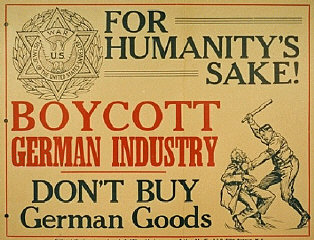|
|

|

|
Poster (issued by the Jewish War Veterans of the United States) calling for a boycott of German goods. New York, United States, between 1937 and 1939. See more photographs |
THE UNITED STATES AND THE HOLOCAUST |
||||
|
|
During World War II, rescue of Jews and other victims of the Nazis was not a priority for the United States government. Nor was it always clear to Allied policy makers how they could pursue large-scale rescue actions behind German lines. Due in part to antisemitism (prejudice against or hatred of Jews), isolationism, the economic Depression, and xenophobia (prejudice against or fear of foreigners), the refugee policy of the U.S. State Department (led by Secretary of State Cordell Hull) made it difficult for refugees to obtain entry visas to the United States. The U.S. State Department also delayed publicizing reports of genocide. In August 1942, the State Department received a cable revealing Nazi plans for the murder of Europe's Jews. However, the report, sent by Gerhart Riegner (the World Jewish Congress [WJC] representative in Geneva) was not passed on to its intended recipient, American Jewish leader and WJC president Stephen Wise. The State Department asked Wise, who had almost simultaneously received the report via British channels, to refrain from announcing it. |
|
The United States failed to act decisively to rescue victims of the Holocaust. On April 19, 1943, U.S. and British representatives met in Bermuda to find solutions to wartime refugee problems. No significant proposals emerged from the conference. In 1943, Polish underground courier Jan Karski informed President Franklin D. Roosevelt of reports of mass murder received from Jewish leaders in the Warsaw ghetto. U.S. authorities did not, however, initiate any action aimed at rescuing refugees until 1944, when Roosevelt established the War Refugee Board (WRB). That year the WRB set up the Fort Ontario Refugee Center in Oswego, NY, to facilitate rescue of imperiled refugees. By the time the War Refugee Board was established, however, four fifths of the Jews who would die in the Holocaust were already dead. By the spring of 1944, the Allies knew of the killing operations using poison gas at the Auschwitz-Birkenau camp. Some Jewish leaders pleaded unsuccessfully with U.S. government officials to bomb the gas chambers and rail tracks leading to the camp. Even after the Anglo-American air forces developed the capacity to hit targets in Silesia (where Auschwitz was located) in 1944, U.S. authorities decided not to bomb the gas chambers or the rail lines. U.S. officials argued that U.S. aircraft did not have the capacity to conduct air raids on these targets with sufficient accuracy, and that the Allies were committed to bomb exclusively military targets to win the war as quickly as possible. |
|
Resources |
|
Breitman, Richard, and Allen Kraut. American Refugee Policy and European Jewry, 1933-1945. Bloomington: Indiana University Press, 1987. Feingold, Henry L. Bearing Witness: How America and Its Jews Responded to the Holocaust. Syracuse, NY: Syracuse University Press, 1995. Gurock, Jeffrey S., editor. America, American Jews, and the Holocaust. New York: Routledge, 1998. Lipstadt, Deborah E. Beyond Belief: The American Press and the Coming of the Holocaust, 1933-1945. New York: Free Press, 1986. Neufeld, Michael J., and Michael Berenbaum, editors. The Bombing of Auschwitz: Should the Allies Have Attempted It? New York: St. Martin's Press, 2000. Wyman, David S. Paper Walls: America and the Refugee Crisis, 1938-1941. New York: Pantheon Books, 1985. Wyman, David S. The Abandonment of the Jews: America and the Holocaust, 1941-1945. New York: The New Press, 1998. |
|
|
|
|